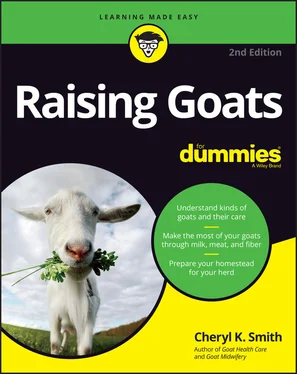Determine what kind of meat goats are available and for what price.
Consider slaughter options. Would you slaughter goats yourself, sell them at auction, have a mobile slaughter provider come out, or transport your goats to a slaughterhouse? Do you have a vehicle to transport goats? Is there a USDA-certified slaughter facility nearby that handles goats? Factors affecting this decision include laws governing slaughter as well as the local market, your capabilities, and financial considerations.
I talk in much more detail about raising goats for meat in Chapter 16.
Some of the finest fiber comes from goats: Angora and Pygora goats produce mohair, cashmere goats produce cashmere, and crosses between the two breeds produce a fiber called cashgora. An adult angora goat can produce an average of 8 to 16 pounds of mohair each year, and a kid can produce 3 to 5 pounds. Cashmere and cashgora-producing goats produce less fiber, but it is also more highly valued.
If you raise fiber goats, you can spin your own yarn and make hats, blankets, sweaters, or other products. You can also sell the fiber to spinners or to companies that make these products, while having the benefit of these friendly creatures.
Check out Chapter 18to find out about harvesting and using goat fiber.
Harnessing goats’ power as living weed whackers
Goats are well-known for their ability to wipe out weeds. In fact, some people have made businesses out of renting out their goat herds to cities and other municipalities to clean up areas that are overgrown with weeds or blackberry bushes. These leased goats decrease the need to use herbicides, improve the soil’s fertility, decrease the risk of fire, increase the diversity of plants in the area, and control weeds in hard-to-reach areas, such as steep hills.
 Because goats are browsers, they can share or alternate a pasture with sheep or cattle, which prefer different plants. Goats eat brush, leaves, and rough plants. They can improve pasture by removing noxious weeds, clear areas to be replanted with trees, and control leafy spurge, knapweed, Himalayan blackberry, giant ragweed, sunflowers, kudzu, and other weeds.
Because goats are browsers, they can share or alternate a pasture with sheep or cattle, which prefer different plants. Goats eat brush, leaves, and rough plants. They can improve pasture by removing noxious weeds, clear areas to be replanted with trees, and control leafy spurge, knapweed, Himalayan blackberry, giant ragweed, sunflowers, kudzu, and other weeds.
 Not every plant is a great snack for a goat. I tell you about plants you need to keep away from your goats in Chapter 4.
Not every plant is a great snack for a goat. I tell you about plants you need to keep away from your goats in Chapter 4.
Whether your goats are pets, milk producers, meat animals, or serve another purpose, they provide the side benefit of acting as living weed whackers. With some portable fencing or a guardian animal for protection, they range far and wide each day to keep your property free of noxious weeds.
Don’t expect to put them on a lawn and have them mow down the grass, though. “Lawnmower” is the job of sheep, not goats. Goats prefer to eat your rosebushes or lilacs.
No specific breed of goat is named cashmere . However, feral goats from Australia and New Zealand and Spanish meat goats from the southwestern United States can be registered with the Cashmere Goat Association, if they meet the standard. Breeders have produced more productive cashmere goats by selectively breeding good producers from these populations. Cashmeres have the added benefit of being good meat goats.
The term cashmere refers to the undercoat or down that is harvested from a variety of goats. Cashmere is harvested and processed mainly in central Asia, especially China. The fiber produced by up to four of these Asian feral goats in a whole year is required to make just one cashmere sweater — which explains why they are so expensive.
Unless your goats are just pets or brush eaters, you probably want to breed them. If you have dairy goats, you need to breed them to keep a good supply of milk flowing. And you will need to replace any goats you sell or slaughter.
As a dairy goat owner, I supplement my income from selling milk by selling kids and providing buck service. Buck service means leasing a buck for breeding purposes to another goat owner. Buck service is valuable to goat owners who don’t have the space or don’t want the hassle of keeping a buck or who want to get certain genetics into their herd. I tell you more about buck service, and about breeding in general, in Chapter 12.
Using goats for companions or helpers
Goats make great companions, something that more people discover every day. Miniature goats such as the Nigerian Dwarf, Pygmy, and mini dairy breeds are growing in popularity as pets, in both the city and the country. (Check out Chapter 3to find out more about these and other breeds.)
Goats are intelligent and funny, and they’re also a great way to meet people. I had a little goat named Malakai, who was a dwarf Nigerian Dwarf, because of health issues. His petite size made him all the more adorable. He was house- and car-broken, and so I took him with me wherever I went. He was the little Mystic Acres farm emissary and never failed to attract people. Besides helping me meet people, Malakai gave me the opportunity to educate people about goats and clarify their inevitable misunderstandings. (Get into goats, and you’ll find that misconceptions abound. I brace you to take on the most common of them in Chapter 20.)
 Normally considered livestock, goats can make good pets, but you will be much more satisfied using them for this purpose if you remember that they are outdoor animals and that’s where they do best. Goats are herd animals and need another goat for a friend, so get at least two of them. I tell you more about choosing your goats in Chapter 5.
Normally considered livestock, goats can make good pets, but you will be much more satisfied using them for this purpose if you remember that they are outdoor animals and that’s where they do best. Goats are herd animals and need another goat for a friend, so get at least two of them. I tell you more about choosing your goats in Chapter 5.
You can leash train goats and take them on walks throughout the neighborhood or around your property, which provides exercise for all of you. ( Chapter 8shows you how to get started leash-training.) I can tell you from experience that just sitting and watching goats has a calming effect. Studies of other pets have shown that they can lower your heart rate and improve your health — and I’m sure that the same is true for goats as pets.
Finding a helping hoof: Using your goat for packing
Goats are social animals and, after you establish a relationship with them, they love to spend time with you. They enjoy going for hikes and can go almost anywhere you can. Not only that, but they can carry your belongings, they find plenty to eat right there in the wilderness, and they make great companions.
So why not take your goat packing? Ideally, you select a large wether for packing and then take the time to train him to obey commands and to carry your gear. Goats are surefooted, excellent pack animals and can help you work, whether it be gathering wood in the forest or just carrying your belongings on a holiday hike. Chapter 8tells you about training your goat as a pack animal.
Sharing your goat with others
Another way you can use a companion or pet goat is as a therapy animal or a visitor to children, seniors, or other groups who don’t usually see goats. After you train your goats, you can approach teachers, administrators, or activity directors to plan a goat day (or hour). You get to spend time with your goats, and other people get to learn about their unique personalities.
Читать дальше

 Because goats are browsers, they can share or alternate a pasture with sheep or cattle, which prefer different plants. Goats eat brush, leaves, and rough plants. They can improve pasture by removing noxious weeds, clear areas to be replanted with trees, and control leafy spurge, knapweed, Himalayan blackberry, giant ragweed, sunflowers, kudzu, and other weeds.
Because goats are browsers, they can share or alternate a pasture with sheep or cattle, which prefer different plants. Goats eat brush, leaves, and rough plants. They can improve pasture by removing noxious weeds, clear areas to be replanted with trees, and control leafy spurge, knapweed, Himalayan blackberry, giant ragweed, sunflowers, kudzu, and other weeds. Not every plant is a great snack for a goat. I tell you about plants you need to keep away from your goats in Chapter 4.
Not every plant is a great snack for a goat. I tell you about plants you need to keep away from your goats in Chapter 4. Normally considered livestock, goats can make good pets, but you will be much more satisfied using them for this purpose if you remember that they are outdoor animals and that’s where they do best. Goats are herd animals and need another goat for a friend, so get at least two of them. I tell you more about choosing your goats in Chapter 5.
Normally considered livestock, goats can make good pets, but you will be much more satisfied using them for this purpose if you remember that they are outdoor animals and that’s where they do best. Goats are herd animals and need another goat for a friend, so get at least two of them. I tell you more about choosing your goats in Chapter 5.










